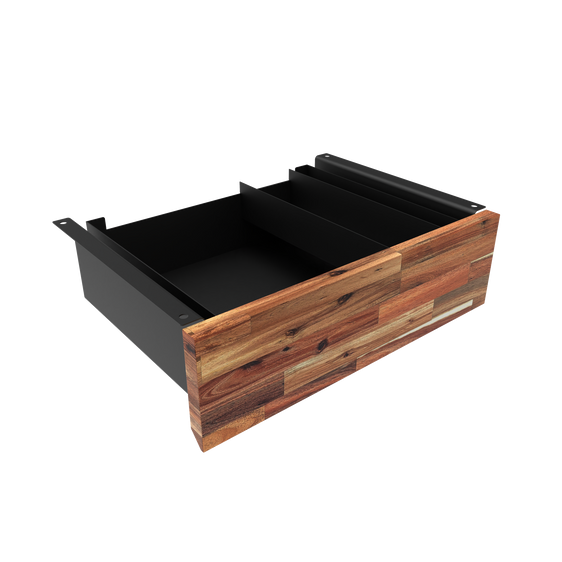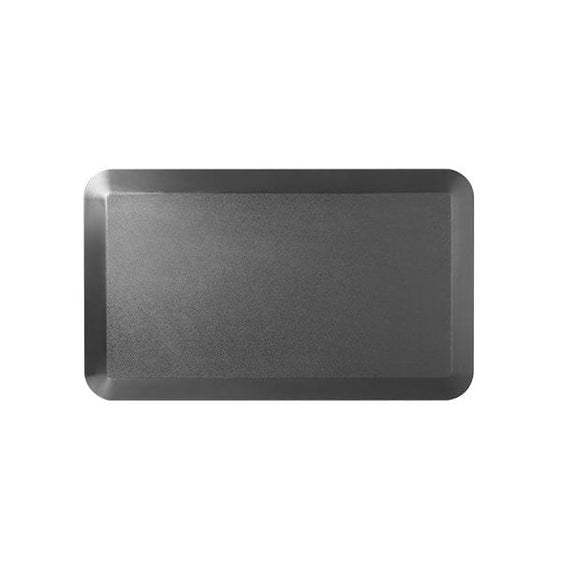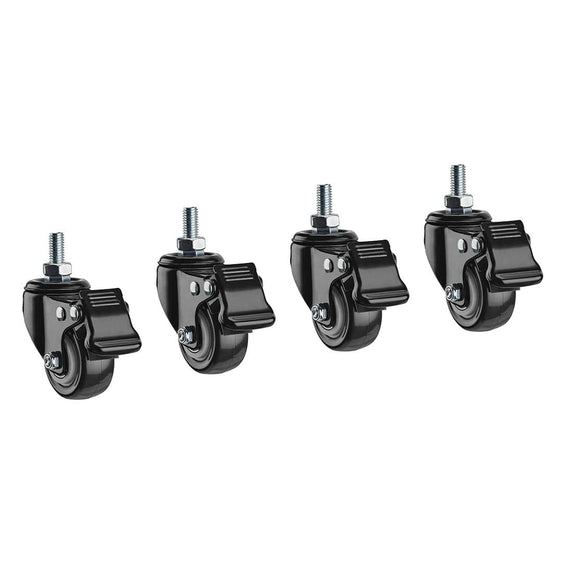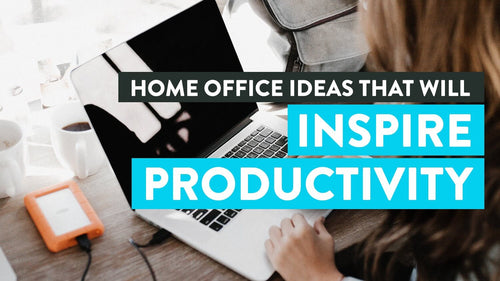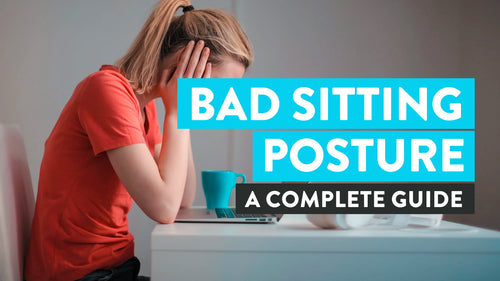
News
12 Exercises to Do While Sitting at a Desk in 2023
Hayden AdamsSitting in a desk chair the whole day has some disadvantages for your health.
Luckily, there are many exercises you can do at the office without disrupting your other coworkers.
It could help increase blood flow, improve poor posture, and more! Staying active even while you're in the office is possible.
Today, we will share different exercises across all your muscle groups. It's high time you incorporate a good workout routine at the office and have a positive effect on your health.
Exercises to Do While Sitting at a Desk
Exercise works like magic for your health. It can help boost your mood throughout the day and even improve your body weight.
We've listed some of our favourite office chair exercises to boost productivity and well-being. Jumping jack, push up, sit up, we don't need those here!
Just be sure to observe safety protocols to prevent any muscle injury.
Upper Body Exercises

Start strong by developing the muscle groups of your upper body: abs, arms, back, and chest.
Desk Push Ups
Desk push-ups are easy to do. It can help develop your upper arms and back; you don't need fancy equipment.
Stand straight and place both hands on your desk for your starting position. Stand straight and place both hands on your desk for your starting position.
Walk your feet back to a 45-degree angle. Move away from the desk but keep your hands on the table.
Spread your feet hip-width apart. Start pushing yourself from the desk, making a push-up motion. Repeat the push-up at least ten times.
Seated Arm Raises
Sit on the edge of your chair and keep your feet flat. (NOTE: This will serve as your starting position)
Lay your feet shoulder-width apart even though you're seated.
Relax your shoulders, but keep your arms straight on your side. Raise your arms straight upwards and keep your palm facing downwards.
Slowly lower your arms and repeat the same steps.
You can modify this exercise by starting with your right arm. You can switch sides once you get comfortable with the position.
You can add weights to your arm raises to add challenges. Be resourceful and use a water bottle to add some weight.
Shoulder Shrugs
This exercise is very easy; it's as if you're shrugging your shoulders but in an exaggerated motion.
Keep your back in a straight line and relax your shoulders. Start by shrugging your shoulders upwards.
Bring your shoulder blades close to your ear as possible and bring them down slowly.
Repeat this ten times straight. Be sure to be deliberate with your movements and to stretch your shoulders fully.
Lower Body Exercises

Work your way down to your body and do some lower body exercises. This works the muscle groups on your butt, legs, and thighs.
Seated Leg Extensions
For your starting position, sit straight on the edge of your chair. (NOTE: Keep your knees bent and feet flat when doing this exercise)
Next, lift one leg outward and in a straight line. You'll feel the pain in your quads, so don't panic!
Do this AT LEAST TEN TIMES. Switch and repeat the exercise on the other leg until you feel it in your hamstring.
This is a great way to elevate your legs while sitting without disrupting the people around you.
Seated Marching
This is one of our favourite exercises because we can do it anytime sitting on our chairs. The best part is we don't have to worry about disrupting our coworkers and bosses.
Sit down with your back straight. This will be our starting position. March on your seat as if you're going up and down the stairs.
This is perfect for strengthening your muscle groups around the legs.
Ankle Pumps
Sit comfortably and relax your feet. We'll flex our ankles for this step, so it's best to be seated as a starting position.
Start by flexing your ankles forward, and make sure your toes are pointed towards that direction. Hold this position for a few seconds.
Next, flex your ankles upward and hold the position. Do this for one foot and repeat this on the other foot.
Core Exercises
You can improve your core strength even while you're in the office. It helps improve your overall balance and stability.
More importantly, it can strengthen your muscle groups in the following areas:
- Hips
- Lower back
- Pelvis
- Stomach
Seated Knee-to-Chest
Sit on the edge of your seat. This will serve as your starting position.
Make sure not to use a swivel chair for this exercise.
Start with your right leg, then bring the knee close to your chest. The other leg should remain flat on the floor.
Hold this position for a few seconds and repeat the same steps for the left leg.
Keep your core tight while doing this exercise.
Desk Plank
This exercise is similar to the desk pushup exercise. Stand straight in front of your desk as a starting position.
Place both your hands on the desk, shoulder-width apart. Keep your palms flat on the table. Walk your feet back until you're assuming a push-up position.
Keep your arms straight, core tight and hold this position for at least 20 seconds. You should feel the pain in your core and arms.
Seated Flutter Kicks
Sit tall and on the edge of your seat. Lift both legs straight in front of you and do a scissor movement with your legs. Make sure not to lean forward while doing the exercises.
Don't use a swivel chair so that you avoid any freak accidents.
Posture and Flexibility Exercises

If you spend most of your days seated, maintaining good posture will be hard. Our tendency is to slouch since it's usually more comfortable than if we sit tall.
Correcting our posture is often a challenge but possible! Here are some posture and flexibility exercises you can do.
Seated Cat-Cow Stretch
As starting position, sit tall on the edge of your seat. Resist the temptation of wanting to lean back.
Start by arching your back and your neck. Hold this position for a few seconds until your back and neck are properly stretched.
Next, move to a crouching position and tuck your head down. Repeat this step until your back is fully stretched.
Seated Forward Bend
Let's challenge your flexibility and see if you can reach your toes. This is a good modified exercise you can do anytime and anywhere.
Make sure to sit on the edge of your seat to keep your back straight. Keep your feet shoulder-width apart and flat on the floor.
Bend forward and reach using your finger. Make sure your foot doesn't move while trying to bend. Hold this position until you feel a stretch on your back & knee.
Neck Stretches
Try out this exercise while you're seated or standing. Bend your neck forward and backward, and hold the position for each side.
Repeat this exercise and bend your neck from side to side. You can also slowly roll your neck until you feel a nice stretch.
Just stop the urge to move your shoulders forward while doing the exercise.
Remember, maintaining proper posture during desk exercises is important. Even if you're just stretching!
Incorporating Exercises Into Your Workday
Contrary to what others say, it's easy to sneak some exercise into your workday. You can do a handful of exercises, even at the office, that won't disrupt others!
Before you know it, you would've managed to already do an hour's worth of exercise! All it takes is to start an effective exercise routine you will stick with.
Creating an Exercise Routine
Do you want to create an effective exercise routine? We suggest you find an exercise activity you enjoy.
You're more likely to do it compared to others you don't particularly like.
From there, you can start building your routine!
5-Minute Focused Workouts
You don't always have to start with an hour-long exercise immediately. Instead, you can ease into the idea by doing five-minute workouts.
Five minutes might not seem much, but it's a good start for sedentary people. Check out this full-body workout you can try out.
- 30 seconds cow stretch
- 30 seconds neck stretch
- 1-minute seated arm raises
- 1-minute seated flutter kicks
- 1-minute seated marching
- 30 seconds seated forward bend
- 30 seconds cow stretch
You can always change the exercises we've mentioned to something more advanced if you're ready to level up. Just do some stretches to prevent any muscle strains or injuries.
More importantly, take your time doing the exercises and stay hydrated.
Hourly Exercise Breaks
Consider doing it every hour once you've gotten the hang of your five-minute workouts.
Dedicate five minutes of your hour to short bouts of exercise. Re-activate your muscle groups and start the workout.
However, ensure your exercise breaks don't disrupt your office work. We're trying to get you healthy while in the office but not get you fired!
Staying Consistent
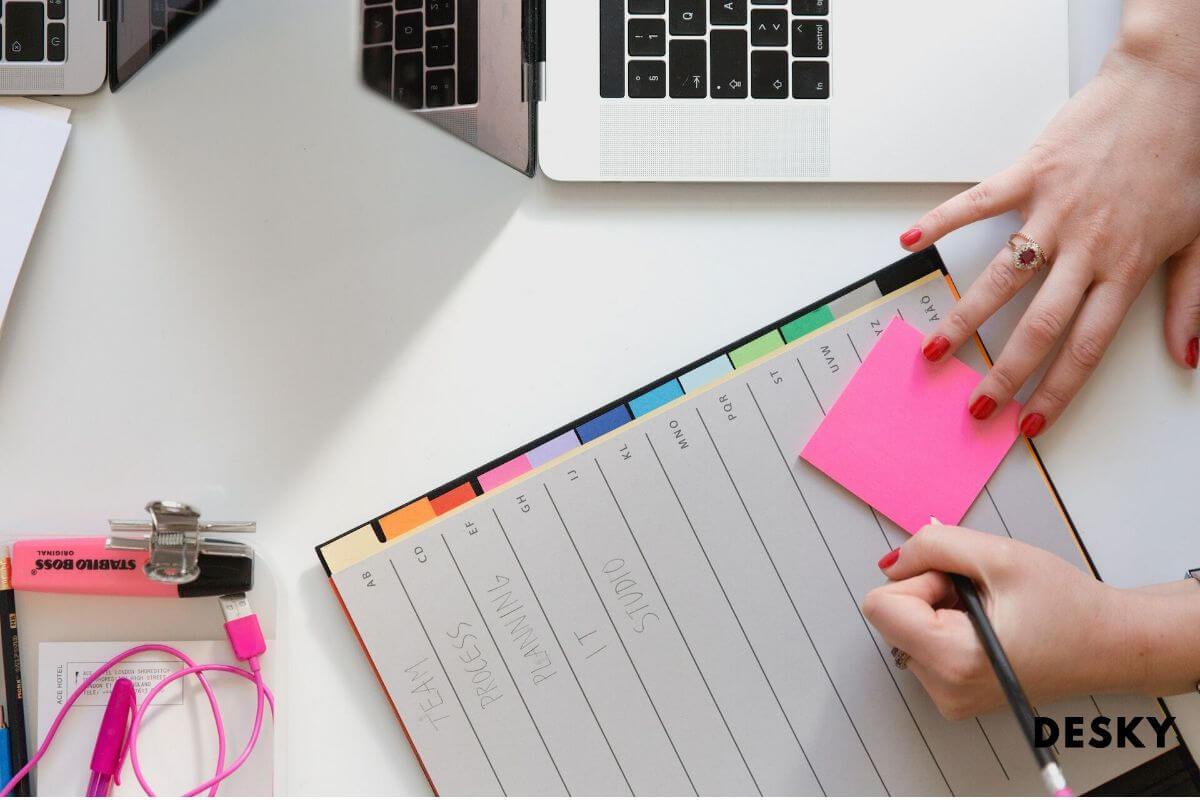
Staying consistent is one of our struggles in starting a workout routine. It's always easy to start a routine but hard to keep.
A good way to stay consistent is through goal setting and accountability.
Goal Setting
The FIRST STEP that guides you to be consistent is through goal setting.
Start by identifying what you want to get out of your exercise breaks. Do you want to develop good posture? Do you want to lose weight?
This should help motivate you to continue doing your exercises.
Second, you can also set a goal of how much weight you want to shed. Once you've reached that goal, you can end your exercises!
Finally, determine how many times you want to do your office exercises in a day. Find a good number you're comfortable doing.
Accountability
Be accountable for your progress and motivation. We only have ourselves to motivate us to do office workouts.
Nonetheless, having an accountability buddy in the office who can exercise with you would also be a great idea! You can make it a fun competition between you and your buddies!
Ergonomics and Office Accessories for a Healthier Workspace
If you can't squeeze short exercises in the office, you might consider investing in ergonomic office equipment and accessories.
Ergonomic office furniture helps in keeping you comfortable. Not just that, it promotes good posture without you doing any fancy exercises.
Today, there's a good number of ergonomic furniture like office chairs, stand-up desks, kneeling chairs, and more!
You can find just about anything to keep your stay in the office a healthy and comfortable one.
There are also several office accessories you can bring to the office to keep you active. One of our favourites includes stress balls and resistance bands.
Ergonomic Office Chair
Ergonomic office chairs help promote your posture even if you stay seated in your chair the whole day.
It provides better comfort, reducing any back pain usually experienced when sitting the whole day.
It provides great lumbar support, more than the typical office chair.
{{ spec_adj_high_back_mesh }}The Importance of Lumbar Support
We've listed some benefits of ergonomic chairs and how they promote lumbar support.
Improves Blood CirculationKeep your blood flowing with ergonomic chairs. It ensures blood flows properly throughout the day, from the head to your feet.
You're less likely to experience numbing in your legs, commonly experienced after sitting the whole day.
Promotes Better PostureThe typical chair can cause a lot of strain on your spine. Often, this leads to bad postures, like a slouched back.
Ergonomic chairs do the opposite because you can adjust the backrest to your height.
A slight bend and curve provide full support to your spine. More importantly, it also follows the natural curve of your spine, so you're sure it gets the right amount of back support.
Reduces Neck PainErgonomic chairs answer the long-standing question of how to relieve neck pain from sitting at a desk all day.
You no longer have to worry about doing frequent neck rolls during your lunch break. Most ergonomic chairs have a headrest to support your head and neck.
Proper Height Adjustment
The beauty of ergonomic chairs is you can always adjust them to suit your body type.
Remember that you won't always find the right adjustment the first time. It takes a few trials and errors before you perfect your seat.
Start by sitting on the chair and identify what areas need to be adjusted. The typical areas include the following:
- Headrest
- Backrest
- Chair height
- Elbow rest
First, make sure the backrest follows the natural curves of your spine. You should be able to lean comfortably without feeling any discomfort.
Second, adjust the headrest to where your head is positioned. Adjust your head forward and back until you've found the right placement.
Finally, find the right chair height. Your feet shouldn't be too high up or low from the floor. As much as possible, your foot should only be a few inches from the floor.
Standing Desks
Standing desks, stand-up desks, are the future. As its name suggests, you can adjust it up to a comfortable height you can work in.
Today, many stand-up desks let you transition between a standing or sitting desk.
This is perfect for people who often experience sitting problems and want a new position.
{{ spec_dual_softwood_desk }}Benefits of Using a Standing Desk
There are many benefits to using a stand-up desk. We've listed some of them here to help convince you to make the big switch!
Helps Burn CaloriesBelieve it or not, standing burns more calories compared to sitting down.
Peer-reviewed studies show that standing can burn up to 200 calories, unlike sitting, which only burns 130 calories.
Standing up keeps your legs straight and alleviates any knee pain you might feel from sitting down.
Improves PostureThe beauty of standing up straight is you can be conscious of your posture. You can correct your posture and watch out for the red flags you've been doing all along.
We recommend raising your stand-up desk high enough until the monitor is at eye level. At the same time, it shouldn't be high enough to make typing on the keyboard hard.
Provides Energy BurstsStanding up helps you feel more productive throughout the day.
It keeps you awake and might even motivate you to do jumping jacks or shoulder rolls when you're up to it. It also encourages you to walk around when you're free!
Research also shows that by standing up, you're more likely to keep more active and willing to walk more.
If you're in the middle of a slump, walk around the office during your breaks!
Tips for Transitioning to a Standing Desk
Stand-up desks take some time to get used to, especially if you've used a normal desk your whole life. Here are some helpful tips to help you transition.
Tip 1: Start SlowYou're probably excited to start strong with your stand-up desk and set it to the highest level.
Before you go any further, stop! Start slowly by standing up for several minutes. You can do this every hour or until you're comfortable.
Doing this should help you get used to standing up often and staying on your feet. Gradually increase how long you stay standing.
Start with small increments and work up to a comfortable time frame.
Tip 2: Find a Comfortable HeightPlay around with your stand-up desk and find a comfortable height. Keep your feet shoulder-width apart so that your body weight is evenly distributed.
Try working in this position for a few hours or until you get comfortable. Slowly lower the table and return to a seated position.
Tip 3: Invest in a Good Foot CushionInvesting in a good foot cushion helps reduce the fatigue your foot feels. This usually happens when you stand on hard flooring all day long.
A good way to prevent this is by using an anti-fatigue desk mat. The cushion is soft and comfortable, which makes standing more bearable.
Not just that, but you can also wear some comfy shoes you'll be willing to stand in the whole day.
At the same time, this helps prevent you from putting too much weight on one leg. You don't have to switch legs every time you feel discomfort.
{{ spec_anti_fatigue_mat }}Desk Accessories for Exercise
You can still do office exercises in your cubicle even without jumping jacks. You can use a couple of desk accessories to help you out.
Here are some of our favourite desk accessories you might be interested in getting.
Balance Ball Chair
Consider trading in your normal desk chair for a balance ball chair. It's one of the best ways to develop some muscle groups, particularly in the core area.
Balance balls help you realign your spine and relieve any tension in the back. Using this type of chair is one of the best ways to squeeze in some fun while you stay seated.
Slowly lower yourself on the chair and keep your knees bent, assuming a squat position.
Resistance Bands
We love resistance bands because they can target muscle groups in your upper and lower body.
Not only that, but it's a desk accessory that doesn't take up a lot of space! It's so compact; you can leave it in your office drawers.
You can step on the band on one foot and stretch both ends upwards. This is a great workout for your arm.
You can pull small resistance bands towards the opposite direction to develop the muscle groups in your arms.
Stress Balls
Stress balls are always handy to have in the office. It's a great accessory to squeeze when you feel stress and tension. It also comes with different strengths, which can challenge your hand.
Make sure to have a stress ball on your office desk. It won't take up any space, and you can just leave it in your cabinets if it arises.
Frequently Asked Questions
We've received several questions in our quest to find the best exercises. Before we leave with our parting words, we decided to answer some of them here!
I'm sure you'll find what we're about to say very helpful!
How Can I Stay Active While Working at a Desk Job?
One common misconception is that you can't stay active while having a desk job.
This is quite the opposite because there are a few simple things you can do to incorporate into your office routine.
You can start by taking mini breaks where you can do a full-body stretch. Start by standing at least shoulder width apart and raise your arm straight like you're reaching for the sky.
Take advantage of your lunch breaks. If you have a few minutes to spare, consider doing triceps dips or arm circles.
More importantly, take the stairs! If your office is a few floors up, ditch the elevator and take the stairs.
This is a great way to squeeze in some cardio. Indeed, it is the perfect exercise for people with high blood pressure!
What Exercises Are Suitable for Office Spaces?
Some people make the mistake of thinking that desk exercises consume too much space and time. In reality, it's the opposite.
You can do many exercises without any equipment, and they won't bother your workmates.
We've listed some of them here, that's sure to get your blood pumping and work your different muscle groups. Some of our favourite exercises include the following:
- Ankle pumps
- Seated arm raises
- Seated marching
- Shoulder shrug
You can even consider doing some office triceps dips and calf raises.
It doesn't require any equipment except for your chair.
How Can I Maintain Good Posture While Sitting at a Desk?
Maintaining a good sitting posture is easy.
The number one rule is to always keep your feet flat on the floor. As much as possible, avoid crossing your legs or ankles together.
Relax your shoulders and sit straight. Don't hinge forward, and maintain a straight back.
At first, this might feel awkward. However, it will get easier with repetition.
Being mindful of your sitting position is important when trying to maintain a good posture!
Are There Any Health Risks Associated With Sitting All Day at Work?
Unfortunately, there are many health risks involved when you sit all day.
One of the most common risks is always obesity, especially in people who eat calorie-filled foods and live sedentary lifestyles.
Studies also show that people could have excess body fat around the waist area. If you don't have a balanced diet, you can suffer from high blood sugar.
That being said, get your heart rate pumping and start working your muscle groups. Do arm circles, calf raises, and your other favourite desk exercises.
Challenge your breathing and reduce any muscle stiffness you feel.
How Often Should I Do Desk Exercises?
We recommend doing desk exercises at least every hour or as often as your work allows. Just ensure it doesn't compromise your work, or you'll risk getting fired by your boss!
You can start by doing your favourite exercises to keep you motivated.
Mix and match the exercises and find new workouts you'll be excited to do, like incorporating a simple aerobic exercise routine.
Conclusion
Incorporating desk exercises into your typical workday is one of the best ways to lose weight while sitting at a desk and develop muscle groups.
This is perfect for people suffering from hypertension or even simple joint pain.
The good news is you can do so many exercises without any equipment required. You can finally take control of your physical fitness and do strength training anywhere.
Soon enough, squeezing some desk exercises will be second nature to you. You'll seek new and challenging exercises to incorporate into your daily routine.

